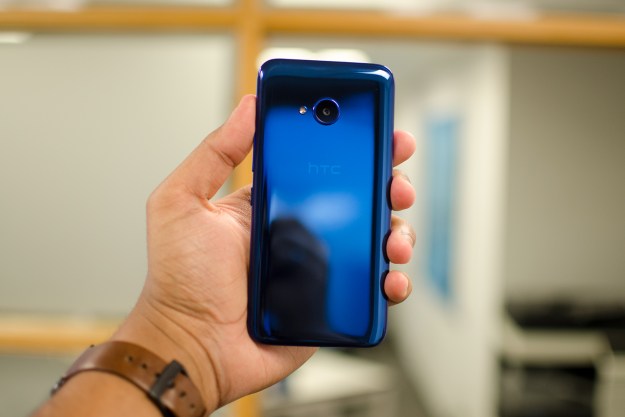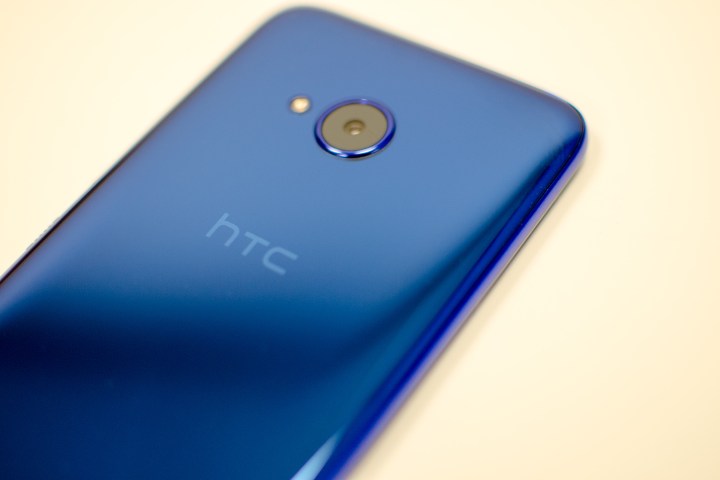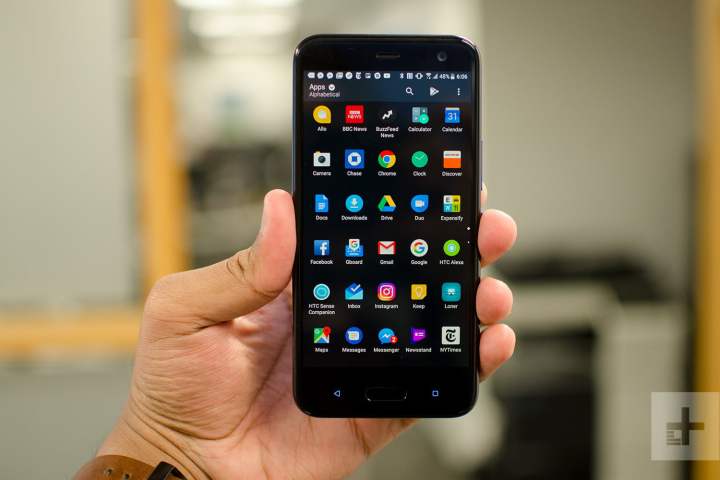
- Affordable
- Good design
- Bluetooth 5, NFC
- Solid performance
- IP67 water-resistance
- No headphone jack
- Camera has slight shutter lag
- Battery could be better
The HTC U11 has it all: A gorgeous design, a great camera, smooth performance, and good battery life. But like most other Android flagship smartphones, it’s expensive at $650. To reach a wider audience, HTC’s bringing similar features and the U11’s design to the new U11 Life, all for just $350. In our review, we like what we see with the HTC U11 Life, and what you get for the low price tag makes it absolutely worth it.
A similar gleam of sapphire
The HTC U11 Life is a smaller, lighter U11 twin — put the two together and it’s hard to note many differences other than size. The U11 Life sports a 5.2-inch screen, as opposed to the the 5.5-inch U11. It makes the phone feel far more compact, though, making it easy to access the other side of the screen in one-handed use.
Weight is also an easy tell, as the U11 Life is 27g lighter than the U11. That’s largely due to the choice of build materials. The more expensive U11 is wrapped in glass, and it features the “liquid-glass” material that helps it give off a reflective shine. The Life feels more plasticky, but HTC mimics the shiny sapphire gleam with acrylic, a type of polymer.
The sapphire blue U11 Life is a little more muted in color; it’s not as shiny, and it doesn’t change colors in different lighting. It’s still unique, attractive, and you only have to worry about shattering the display’s glass if you drop it. The rear is fairly minimal, as you’ll only find a circular camera at the top, a flash next to it, and the HTC logo below.
On the right edge of the phone is a textured power button below the volume rocker. These buttons are a little too low for our liking, as we found we often have to shift the U11 Life up a little to tap the power button. One handy workaround, though, is to double tap the lock screen to wake or turn off the screen.
The HTC U11 Life’s sapphire gleam is still unique, and it looks attractive.
The low buttons also make it harder to use Edge Sense. This is a feature first introduced in the HTC U11, which lets you squeeze the bottom part of the phone to trigger an action, from opening Google Assistant to flicking on the flashlight — whatever you fancy. Google liked this feature enough to license it from HTC for use in its new Pixel 2 and Pixel 2 XL smartphones to activate Assistant. It’s now in the $350 U11 Life, and it works as advertised, though you have to make sure you don’t hit the power button. We should note, I have large hands, so this may not be a problem for other people.
Like most phones in its price range, the U11 Life doesn’t have skimpy edges around the screen, or what’s known as a “bezel-less” design. You’re out of luck if you want an HTC phone with this look in the U.S., because the just-announced U11 Plus, which has ultra-thin bezels, and a 6-inch 18:9 screen, isn’t coming to the U.S.
At least it’s not empty space — the fingerprint sensor, which doubles as a home button, sits on the bottom chin, and it’s flanked by two capacitive Android navigation buttons that light up when in use (or when the screen is on). The front-facing camera rests at the top, to the right of the earpiece.
HTC opts for a USB Type-C charging port like most flagship Android phones, but it’s situated oddly on the bottom right edge. The company told us the fingerprint sensor prevented placing it in the usual center spot, but we didn’t have any issues with the odd location. USB-C is both faster charging and more versatile than MicroUSB, which made it nice to see in this price range. Most budget Motorola phones, like the Moto G5S Plus, still use MicroUSB.
There’s no headphone jack, but that’s hardly a surprise considering HTC hasn’t used included one on most of its phones this year. Instead, you’ll get the company’s USB-C USonic headphones in the box. They’re decent — maybe a little too bass-heavy — but they adapt to the shape of your ear (after a quick setup process) and they offer Active Noise Cancellation. The noise cancellation is marginal, and there’s a strong hissing noise that’s distracting. Still, it’s nice USB-C earbuds are included in the box.
The only speaker, on the bottom edge at the center, can get fairly loud, but don’t expect much. It seems to artificially boost bass a little, but the highs sound pretty good.
Thankfully, HTC uses Bluetooth 5, which is a newer version of the technology that offers faster data transfer and improved range. It’s a welcome feature, especially considering the flagship Huawei Mate 10 Pro removes the headphone jack but only uses the dated Bluetooth 4.1.
The U11 Life is IP67-rated, making it one of the most affordable water-resistant phones on the market. It’s tough to find a good phone with water-resistance, and the only comparable product in this price range is the Moto X4.
An average display, but surprisingly good performance
The 5.2-inch LCD screen offers a standard 1,920 x 1,080 pixel resolution, and it’s nothing to write home about. It doesn’t get as bright as we’d like and it’s not as colorful as an OLED panel, but it’s still barely visible in direct sunlight. Still, everything looks sharp and we didn’t have any major qualms with it.

Performance, on the other hand, surprised us. The HTC U11 Life is powered by Qualcomm’s Snapdragon 630 processor, with 3GB of RAM. Not many phones have this new chipset, but we saw it recently in Motorola’s Moto X4. We think the U11 Life performs better than the Moto X4, but the benchmark results are comparable.
- AnTuTu: 71,397
- Geekbench 4 CPU: 855 single-core, 4,078 multi-core
- 3DMark Sling Shot: 817
These scores are marginally better, if not the same, as what the Moto X4 received. For example, the Moto X4 scored 70,217 on AnTuTu, and 840 on 3DMark. The U11 Life did beat out the X4 on single-core in Geekbench 4, but it’s down in multi-core. Benchmarks aren’t the be-all end-all of performance, but we’ve generally noticed everything on the U11 Life is a little smoother, with fewer snags, than the X4. It’s a good middle-ground between what you’ll find on slightly cheaper phones like the Moto G5S Plus and the Moto G5 Plus, and flagship-priced phones with the Snapdragon 835, like the Google Pixel 2 XL.
Performance, on the other hand, surprised us.
Scrolling through apps like Twitter was speedy, and the phone opens apps swiftly — though still a tad slower than a flagship phone with the Snapdragon 835, like the U11. We did run into a occasional stutter, but overall we’re satisfied with performance on this phone. Games like Transformers: Forged to Fight and Loner ran well without any glaring problems.
The HTC U11 Life comes with 32GB of storage, but there’s a MicroSD card slot that lets you increase it up to 2TB if you need more space.
Android 7.1.1 and three assistants
The U.S. model of the HTC U11 Life runs Android 7.1.1, overlaid with HTC’s Sense user interface. This means you’ll find quite a few HTC apps — some bloatware — and Blinkfeed, which shows you news articles you may like and even ads (you can turn ads and even Blinkfeed off). It’s not great that the U11 Life isn’t shipping with the most recent version of Android, Android 8.0 Oreo, which has been out since August. But before you protest, HTC said the Oreo update will arrive by the end of November, perhaps even for the HTC U11. That’s impressive, as there still aren’t a lot of phones that have received 8.0 Oreo.
HTC’s user interface feels a little cluttered and clunky, but it’s all easily manageable and there’s a lot of theming you can do to personalize the phone’s look. Most of the software looks like pure Android, and it’s easy to follow and use.
There are three artificial assistants on board, which can make things confusing, but it also provides you with more options. There’s Google Assistant, which you can activate via Edge Sense, by pressing and holding the home button, or by saying “OK Google.”
Then there’s Amazon’s Alexa, but unlike the HTC U11, you can’t use a voice trigger to activate it. This is because the Snapdragon 835 in the U11 allows for two wake words, but the Snapdragon 630 does not. So you can either map Alexa to Edge Sense, or just open the app and start talking. There are no visual cues with Alexa, so you’ll strictly have to rely on its voice when using it. We prefer using Google Assistant particularly for this reason, but Alexa support is a welcome backup if you have Echo devices in your home.
The global model of the U11 Life will not run Sense UI, rather Android One instead.
The third assistant is one we’ve seen in prior HTC phones — Sense Companion. It’s not a voice assistant, but it will float on your home screen when it wants to offer up some relevant information based on the time of day and where you are, such as weather alerts, nearby food recommendations if you’re in a new city, and more. It gets better the more you use your phone, but we haven’t had much use for it in the week we’ve used the U11 Life.
Overall, the software is customizable to your liking, and while there’s some clunky UI elements and bloatware, it’s still better than other devices that tack on heavy Android “skins” or “themes” that bog down the system.
You should know the global model of the U11 Life will not run Sense UI, but Android One. It’s a pure Android version of the operating system, with just pre-installed Google apps, Edge Sense, and a promise to receive fast version and security updates as soon as Google releases them.
Say cheese! But stay very still
The U11 Life’s camera is markedly better than any other phone in its price range and below, but it’s still the weakest part of the phone.
It utilizes a 16-megapixel rear camera with a f/2.0 aperture, and the photographs it takes can be good, but most of the time they’re ruined due to the lack of optical image stabilization. You need to be very still to prevent any blurriness, as most of our photos ended up with a slight blur. Details aren’t that sharp, and there’s a lot of grain unless you’re taking a photo in broad daylight. Low-light isn’t great either, as images offer poor detail and they look a little blotchy.
What’s worse is the slight shutter lag, which is the amount of time from when you tap the shutter icon, to when the camera captures a photo. It’s virtually non-existent on higher-end phones like the iPhone X or Pixel 2, but there’s a noticeable delay on the U11 Life.
Still, color accuracy is pretty good, and were genuinely surprised at some photos taken with HDR. It’s unfortunate you have to put so much time and energy on staying absolutely still to try and get a good photo in focus.
Shutter lag and a lack of optical image stabilization hobble just about every budget phone. We’ve had the same issues with the comparably-priced Moto X4, for example, though the shutter lag was much worse.
Despite the unusual 16-megapixel front-facing camera with f/2.0 aperture, there’s not much interesting here. Slight movements, again, can produce blurry photos, and selfies can be quite grainy in anything other than direct sunlight.
Average battery life
The HTC U11 Life has a 2,600mAh battery capacity, and it may not last you a full day with heavy use. After taking it off the charger at 8 a.m., we used it to browse the web, play some music and games, download dozens of apps, watch a YouTube video or two, run benchmarking apps, and take photos. The end result was 17 percent charge by 5:30 p.m.
That’s not bad, considering the workload we pushed on the U11 Life. You’ll be able to use the phone for just about full day, though with heavy use you may want to bring a portable battery pack or charging cable. If you’re a light user, this phone will easily get you through a day.
There’s nothing remarkable about the U11 Life’s charging speed. We saw it go from 15 percent to 50 percent within 35 minutes.
Price, availability, and warranty
The HTC U11 Life is available unlocked from HTC’s website for $350. The only carrier that’s selling the phone is T-Mobile, and it will be available on November 3 at a even lower price. On a monthly payment plan, it will set you back $12 per month for 24 months after $12 down, or about $300. HTC said the U11 Life will work on AT&T’s network if you buy it on its website, though you won’t be able to use it on Verizon and Sprint.
HTC offers a standard limited warranty that protects your device of manufacturing defects for one year since the date of purchase.
Our Take
HTC’s U11 Life will catch your eyes with its sapphire gleam, and your wallet will thank you. It offers great performance and water resistance, though the battery is average and the camera is hindered by shutter lag.
Is there a better alternative?
It’s a tough call in this price range. The Moto X4 is $50 more and shares many of the same specifications and features as the U11 Life, but we’re not fans of the camera at all.
The Moto G5S Plus has a mediocre camera, but only slightly diminished performance, and it’ll set you back $280. It has a metal build, but it’s not water-resistant and it doesn’t look good.
For better performance and camera, you’ll have to look to the $480 OnePlus 5. It has the Snapdragon 835 processor, and a good dual camera that lets you use fun features like Portrait Mode. You may want to wait, as there are rumblings of a OnePlus 5T in the works.
How long will it last?
HTC has been improving its speed in providing software updates for its phones. Case in point: The HTC U11, which arrived this summer, is going to get Android 8.0 Oreo later this month. That’s far better than most manufacturers. Still, we expect this phone to last no more than two years. Since it’s low on the totem pole, we can’t even guarantee a version update after the second year.
It’s IP67 rated, so it can handle a dip in the pool. There’s no glass on the back, so you only need to make sure you protect that screen.
Should you buy it?
Yes. At this price range, the HTC U11 Life is the best phone you can buy. We think it’s better than its closest competitor, the Moto X4, and it certainly beats the Moto G line.
















